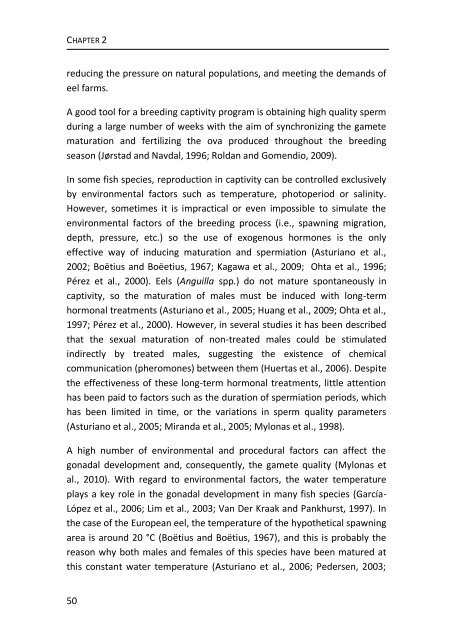chapter 3 - RiuNet
chapter 3 - RiuNet
chapter 3 - RiuNet
Create successful ePaper yourself
Turn your PDF publications into a flip-book with our unique Google optimized e-Paper software.
CHAPTER 2<br />
reducing the pressure on natural populations, and meeting the demands of<br />
eel farms.<br />
A good tool for a breeding captivity program is obtaining high quality sperm<br />
during a large number of weeks with the aim of synchronizing the gamete<br />
maturation and fertilizing the ova produced throughout the breeding<br />
season (Jørstad and Navdal, 1996; Roldan and Gomendio, 2009).<br />
In some fish species, reproduction in captivity can be controlled exclusively<br />
by environmental factors such as temperature, photoperiod or salinity.<br />
However, sometimes it is impractical or even impossible to simulate the<br />
environmental factors of the breeding process (i.e., spawning migration,<br />
depth, pressure, etc.) so the use of exogenous hormones is the only<br />
effective way of inducing maturation and spermiation (Asturiano et al.,<br />
2002; Boëtius and Boëetius, 1967; Kagawa et al., 2009; Ohta et al., 1996;<br />
Pérez et al., 2000). Eels (Anguilla spp.) do not mature spontaneously in<br />
captivity, so the maturation of males must be induced with long-term<br />
hormonal treatments (Asturiano et al., 2005; Huang et al., 2009; Ohta et al.,<br />
1997; Pérez et al., 2000). However, in several studies it has been described<br />
that the sexual maturation of non-treated males could be stimulated<br />
indirectly by treated males, suggesting the existence of chemical<br />
communication (pheromones) between them (Huertas et al., 2006). Despite<br />
the effectiveness of these long-term hormonal treatments, little attention<br />
has been paid to factors such as the duration of spermiation periods, which<br />
has been limited in time, or the variations in sperm quality parameters<br />
(Asturiano et al., 2005; Miranda et al., 2005; Mylonas et al., 1998).<br />
A high number of environmental and procedural factors can affect the<br />
gonadal development and, consequently, the gamete quality (Mylonas et<br />
al., 2010). With regard to environmental factors, the water temperature<br />
plays a key role in the gonadal development in many fish species (García-<br />
López et al., 2006; Lim et al., 2003; Van Der Kraak and Pankhurst, 1997). In<br />
the case of the European eel, the temperature of the hypothetical spawning<br />
area is around 20 °C (Boëtius and Boëtius, 1967), and this is probably the<br />
reason why both males and females of this species have been matured at<br />
this constant water temperature (Asturiano et al., 2006; Pedersen, 2003;<br />
50
















